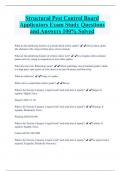Summary
Summary AQA A level Media - The relationship of the media, content, presentation and audiences
- Institution
- AQA
These notes explore passive and active audience theories by covering key models like the Hypodermic Syringe Model, Two-Step Flow Model, and the Uses and Gratifications Model. You'll also find critiques of these models, discussions on violence in media, and effects such as desensitization, imita...
[Show more]












